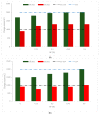Basalt Fiber Reinforced Concrete: A Compressive Review on Durability Aspects
- PMID: 36614766
- PMCID: PMC9822047
- DOI: 10.3390/ma16010429
Basalt Fiber Reinforced Concrete: A Compressive Review on Durability Aspects
Abstract
The creation of sustainable composites reinforced with natural fibers has recently drawn the interest of both industrial and academics. Basalt fiber (BF) stands out as the most intriguing among the natural fibers that may be utilized as reinforcement due to their characteristics. Numerous academics have conducted many tests on the strength, durability, temperature, and microstructure characteristics of concrete reinforced with BF and have found promising results. However, because the information is dispersed, readers find it problematic to assess the advantages of BF reinforced concrete, which limits its applications. Therefore, a condensed study that provides the reader with an easy route and summarizes all pertinent information is needed. The purpose of this paper (Part II) is to undertake a compressive assessment of basalt fiber reinforced concrete's durability features. The results show that adding BF significantly increased concrete durability. The review also identifies a research deficiency that must be addressed before BF is used in practice.
Keywords: basalt fibers; scan electronic microscopy; shrinkage; thermal properties.
Conflict of interest statement
The authors declare no conflict of interest.
Figures




















References
-
- Handayani L., Aprilia S., Abdullah A., Rahmawati C., Abdullah M.M.A.B., Aziz I.H., Azimi E.A. Synthesis of Sodium Silicate from Rice Husk Ash as an Activator to Produce Epoxy-Geopolymer Cement. J. Phys. Conf. Ser. 2021;1845:012072. doi: 10.1088/1742-6596/1845/1/012072. - DOI
-
- Smirnova O.M., Menéndez Pidal de Navascués I., Mikhailevskii V.R., Kolosov O.I., Skolota N.S. Sound-Absorbing Composites with Rubber Crumb from Used Tires. Appl. Sci. 2021;11:7347. doi: 10.3390/app11167347. - DOI
-
- Chevuri V.R., Sridhar S. Usage of Waste Foundry Sand in Concrete. Int. J. Civ. Eng. 2015;2:5–10. doi: 10.14445/23488352/IJCE-V2I12P102. - DOI
-
- Lee H., Hanif A., Usman M., Sim J., Oh H. Performance Evaluation of Concrete Incorporating Glass Powder and Glass Sludge Wastes as Supplementary Cementing Material. J. Clean. Prod. 2018;170:683–693. doi: 10.1016/j.jclepro.2017.09.133. - DOI
-
- Chavan S., Rao P. Utilization of Waste PET Bottle Fibers in Concrete as an Innovation in Building Materials—[A Review Paper] Int. J. Eng. Res. 2016;5:304–307.
Publication types
LinkOut - more resources
Full Text Sources
Miscellaneous

